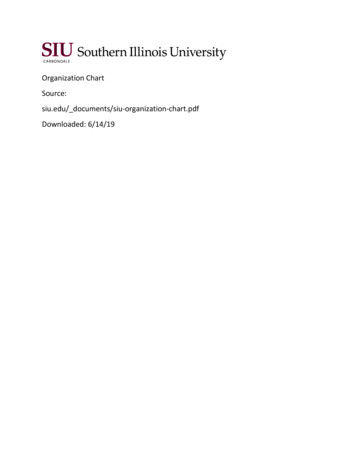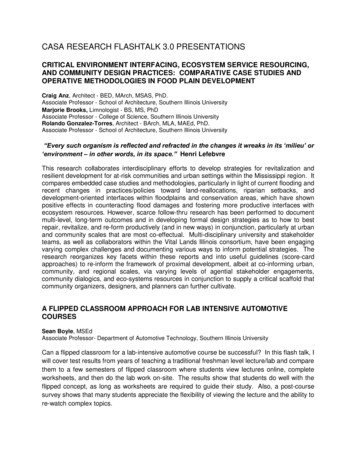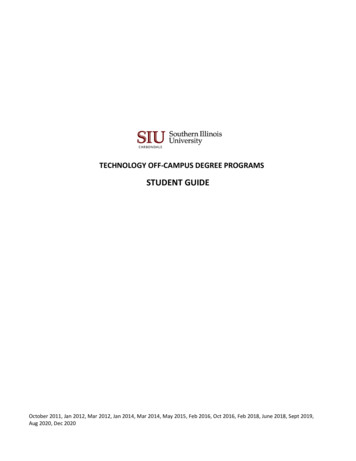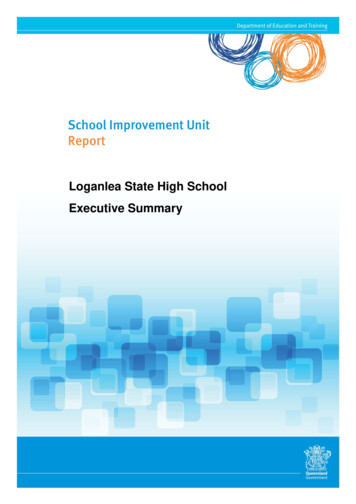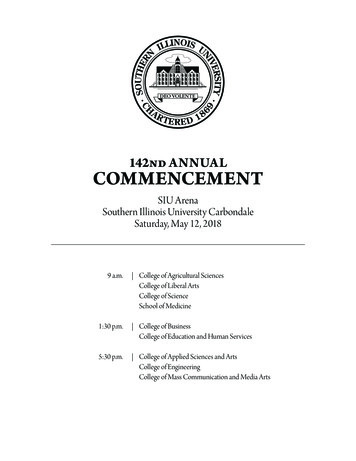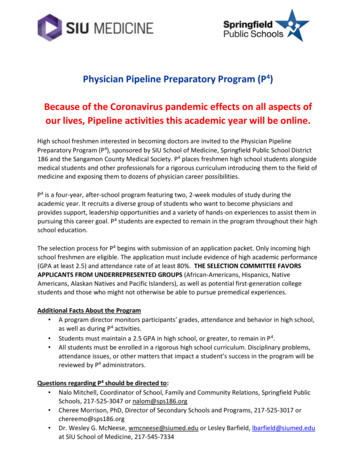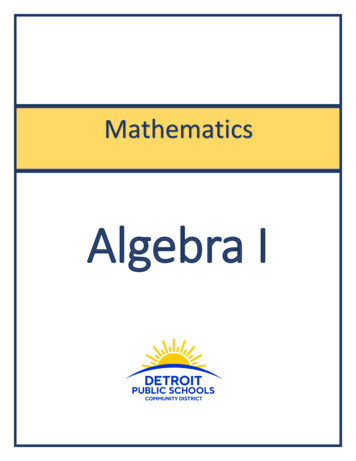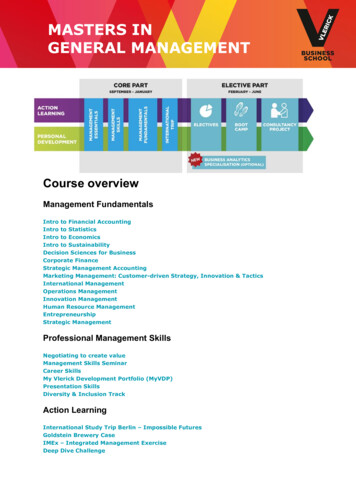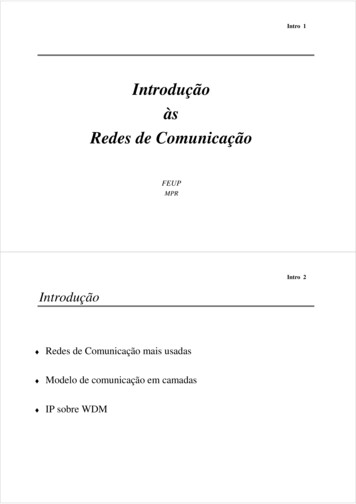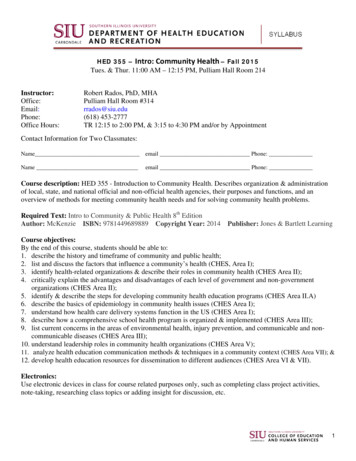
Transcription
SYLLABUSHED 355 –Intro: Community Health – Fall 2015Tues. & Thur. 11:00 AM – 12:15 PM, Pulliam Hall Room 214Instructor:Office:Email:Phone:Office Hours:Robert Rados, PhD, MHAPulliam Hall Room #314rrados@siu.edu(618) 453-2777TR 12:15 to 2:00 PM, & 3:15 to 4:30 PM and/or by AppointmentContact Information for Two Classmates:Name email Phone:Nameemail Phone:Course description: HED 355 - Introduction to Community Health. Describes organization & administrationof local, state, and national official and non-official health agencies, their purposes and functions, and anoverview of methods for meeting community health needs and for solving community health problems.Required Text: Intro to Community & Public Health 8th EditionAuthor: McKenzie ISBN: 9781449689889 Copyright Year: 2014Publisher: Jones & Bartlett LearningCourse objectives:By the end of this course, students should be able to:1. describe the history and timeframe of community and public health;2. list and discuss the factors that influence a community’s health (CHES, Area I);3. identify health-related organizations & describe their roles in community health (CHES Area II);4. critically explain the advantages and disadvantages of each level of government and non-governmentorganizations (CHES Area II);5. identify & describe the steps for developing community health education programs (CHES Area II.A)6. describe the basics of epidemiology in community health issues (CHES Area I);7. understand how health care delivery systems function in the US (CHES Area I);8. describe how a comprehensive school health program is organized & implemented (CHES Area III);9. list current concerns in the areas of environmental health, injury prevention, and communicable and noncommunicable diseases (CHES Area III);10. understand leadership roles in community health organizations (CHES Area V);11. analyze health education communication methods & techniques in a community context (CHES Area VII); &12. develop health education resources for dissemination to different audiences (CHES Area VI & VII).Electronics:Use electronic devices in class for course related purposes only, such as completing class project activities,note-taking, researching class topics or adding insight for discussion, etc.1
SYLLABUSAssessment Grading Scale:Based on total points received, the grading scale is as follows:100-90%A89-80%B79-70%C69-60%DUnder 60% F2 ExamsTri-fold BrochurePublic Service AnnouncementCommunity Health OutreachService Learning ExperienceD2L & In-class ActivitiesAttendance/Engagement200 pts. (2 x 100 pts. ea.)70 pts.30 pts.70 pts.175 pts.50 pts.105 pts.Total: 700 pts.Taking exams on schedule is policy, unless for a University sanctioned event. If you know ahead that you will miss a test (i.e. athlete,university sanctioned class event, military, etc.) request (in person) a make-up before test day. You must also provide a note, inwriting, from a coach or professor. Excused absences must be approved in advance and make-up exams are not provided for anunexcused absence. In-class activities, or quizzes, may not be made up on days missed. You are responsible for obtaining anyinformation missed - if you miss class, utilize student contacts to find out what you missed.Please notify instructor for any other reasons for missed exams ASAP.Late Policy: Assignments are expected to be turned in on the assigned due date. Late assignments, if notapproved by the instructor will not be accepted or may receive ½ the normally earned points.ASSIGNMENTS:2 Exams: (2 x 100 pts. ea.)There will be two exams given based on the text, lectures, and class discussions. The exams will consist ofmultiple choice or matching.Tri-fold Brochure: (70 pts.)Each student will create a tri-fold brochure focusing on a health-risk behavior or community health issue. Thepurpose could be to: teach people how to do something, provide information about a health related concern or announce a program, organization or event.Brochures will include written content, graphic design/photo elements that convey the purpose of the brochureand include a call to action appealing for the target population. The tri-fold brochure will be submitted alongwith a separate written summary to briefly explain the reasons for creating this type of brochure, why thecontent and graphic design elements were used with the target population, and how the brochure would beutilized/distributed. What resources would be used to create the tri-fold brochure (details in class.)Public Service Announcement: (30 pts.)Develop a 30-second public service announcement (PSA) for radio, television or internet. PSAs will bepresented in class (read, video, Ppt.) A written summary paper will accompany the PSA. It is suggested thatstudents use the same topic/event used for the tri-fold for their PSA.2
SYLLABUSCommunity Health Outreach: (70 pts.)Each student will attend a community or public health related outreach event (your choice). Students will writea 2-page summary paper describing each of the following components (10 pts. ea. 50 pts.):1. Describe the overall event, noting the size of the event/# people involved, sponsor(s) and fundingsource(s). When & where the event was held? (Take pictures of yourself at the event!)2. What was the goal of the activity or event?3. Who was the target audience?4. What was the health education message, and what channel(s) of communication were used?5. Critique the effectiveness of the community public health message for the event. What worked well?What could be done differently? How was the response & why? Also, other relevant comments!The Student Center, Student Health Clinic, DOH, health advocacy groups, newspapers or non-profitorganizations are good places to check for upcoming events (more details in class).Service Learning Experience (SLE): (175 pts.) Three part assignment - SLE (100 pts.), SLE Folder (50 pts.) & SLE Presentation (25 pts.)SLE (100 pts.) - Each student will select a field site organization to complete an 8-hour SLE. Service learningblends classroom learning with the practical application of that knowledge through service (i.e., non-paid)Service learning provides an insider’s perspective of how things work within an organization, and offeringparticipants a sense of gratification by supporting a worthwhile organization and their clients.SLE locations may include social service agencies, volunteer organizations, non-profits, faith based programs,healthcare or nursing facilities, Health Dept., school health programs and shelter/charity organizations, etc.Contact SIU Center For Service-Learning &Volunteerism: http://www.cslv.siu.edu/students/svc/faq.htmlThe SLE should meet the following requirements: The site is related to community public health, health education or risk factors for health.Experience occurs outside of your normal work area or regular responsibilities.The site allows 8-hrs. of service during the semester (over more than a one day period of time).Experience will need to provide meaningful involvement (e.g. helping to plan, develop, teach, write,design, research or shadowing a key worker in the organization for only part of learning experience.Each student is required to interact with the instructor regarding SLE arrangements:1st interaction is for prior approval of the SLE site, and the 2nd interaction to ensure that assignmentrequirements are actually going to be fulfilled for SLE as intended (more details provided in class).SLE Folder (50 pts.) – You will complete a SLE folder that includes the following hardcopy components:1. Provide a brief history of the organization, management structure, how you became involved with theorganization and a description of the program(s) you experienced2. Create a log of when and how you interacted for all hours and an entry for each visit discussing:a. What you leaned, what you did and how you were guided, and impressions regarding the visitb. Describe people you interacted with and any other comments, avoid names to maintain confidentiality3. Collect Artifacts like materials you created, photos of you on location, meeting agendas/minutes, etc.4. Prepare a written analysis of your overall SLE addressing the following:a. How the SLE related to community and public health?b. How did the SLE contribute to your understanding of the organization’s role in community health?c. What did you learn about the population being served?d. What did you learn about yourself and your career goals?e. What SLE recommendations do you have for this project in future semesters?5. Copy of thank you letter for the SLE supervisor and other docs. (E.g. letter of recommendation, etc.)3
SYLLABUSSLE Presentation (25 pts.) - Students will present a 10-minute in class SLE summary, with PowerPoint andsubmit the SLE portfolio folder on the day of the presentation.The SLE Presentation will include the following: Describe the organization for which you provided service. What organization was it? How is theorganization structured? How is it funded? What role does it play in community health services? Whatpopulation does it serve? Include some additional public health info. and/or relevant statistics (outside resource like the CDC, orJournal Article) regarding the area of your SLE and list the reference source. What types of activities did you perform? What challenges did you face? Identify the most rewarding aspect of your service learning experience. Knowing what you know now, what would you have done differently?D2L & In-class Activities (multiple activities total 50 pts.): May consists of scheduled and unscheduledindividual/group work to express your personal responses regarding feelings, values, beliefs, experiences,opinions and comments to situations, guest speakers, event, video and/or information covered in the class.Details TBA during the semester or provided on the day of the activity.Attendance/Engagement (105 pts.)The course is a face-to-face learning experience designed for students to physically attend class and participatein covering materials, interact with classmates and share personal experiences, knowledge, opinions, values aswell as beliefs regarding topics. Points are earned for each day a student addends an official day of class,beginning Tues. 9/25/15 (absences, including missed late-start days do not earn attendance/engagement points.)Tentative Class Outline* (See D2L for possible additional readings, assignments and activities per week.)DateWeek 1Tue. 8/25Thur. 8/27Week 2Tue. 9/1Thur. 9/3Week 3Tue. 9/8Thur. 9/10Week 4Tue. 9/15Thur. 9/17Week 5Tue. 9/22Thur. 9/24TopicIntroductions/student profiles,review syllabusHistory Community and PublicHealthHistory Community and PublicHealthOrganizations Shape Community andPublic HealthAssignmentDueCh. 1Bring to class and submitcompleted student profilew/photo 1st day of classCh. 1 & 2Students make contact tolocate/arrange a SLEEpidemiology – Study of diseaseEpidemiology – Prevention/controlof diseaseCh. 3Ch. 4Community OrganizingSchool HealthMaternal, infant & Child HealthCh. 5Ch. 6Ch. 7Adolescents, Young Adults& AdultsFinish chapters and review for ExamCh. 84
SYLLABUSWeek 6Tue. 9/29Thur. 10/1Week 7Tue. 10/6Thur. 10/8Week 8Tue. 10/13Thur. 10/15Week 9Tue. 10/20Thur. 10/22Week 10Tue. 10/27Thur. 10/29Week 11Tue. 11/3Thur. 11/5Exam IGo over exam / Elders Older AdultsCh. 9Community and Public HealthRacial/Ethnic PopulationsCh. 10Exam I – Ch. 1 through 8FALL BREAK –No ClassMental HealthCh. 11Alcohol, tobacco, & other drugsCh. 12Health Care Delivery SystemsCh. 13Environmental HealthInjuries Emergency PreparednessTri-fold Brochure &PSA dueCh. 14Community HealthOutreachWeek 12Service LearningInjuries as a Community and PublicTue. 11/10Experience (SLE)Ch. 15HealthproblemCompletedThur. 11/12Week 13Safety and Health in the WorkplaceCh. 16Tue. 11/17Thur. 11/19Week 14PresentationsTue. 11/24THANKSGIVING – No ClassThur. 11/26Week 15PresentationsTue. 12/1Thur. 12/3Week 16PresentationsTue. 12/8Review for Exam IIThur. 12/10Exam II Ch. 9 through 16Final Examination WeekWeek 1710:15 AM to 12:15 PMThur. 12/17* Tentative Class Schedule This course outline is subject to change. Additional directions, readings or activities/assignmentswill be added and or modified during the semester. Due dates may fluctuate by the instructor, based on our progress throughthe course materials. You as an active student will be involved in some of the decisions and made aware of changes (e.g. guestspeakers, topic dates, in class activities or other agenda).Emergency ProceduresSouthern Illinois University Carbondale is committed to providing a safe and healthy environment for study and work. Because somehealth and safety circumstances are beyond our control, we ask that you become familiar with the SIUC Emergency Response Planand Building Emergency Response Team (BERT) program. Emergency response information is available on posters in buildings oncampus, available on the BERT’s website at www.bert.siu.edu, Department of Public Safety’s website www.dps.siu.edu (disaster dropdown) and in the Emergency Response Guidelines pamphlet. Know how to respond to each type of emergency.Instructors will provide guidance and direction to students in the classroom in the event of an emergency affecting your location. It isimportant that you follow these instructions and stay with your instructor during an evacuation or sheltering emergency. TheBuilding Emergency Response Team will provide assistance to your instructor in evacuating the building or sheltering within thefacility.5
SYLLABUSPLAGIARISM CODEhttp://pvcaa.siu.edu/ g%20Plagiarism.pdfMORRIS LIBRARY HOURShttp://www.lib.siu.edu/aboutSyllabus Attachment Fall 2015IMPORTANT DATES *Semester Class Begins .08/24/2015Last day to add a class (without instructor permission):. .08/30/2015Last day to withdraw completely and receive a 100% refund: .09/06/2015Last day to drop a course using SalukiNet:. .11/01/2015Last day to file diploma application (for name to appear in Commencement program): . .09/18/2015Final examinations: 12/14–12/18/2015Note: For outreach, internet, and short course drop/add dates, visit Registrar’s Academic webpagehttp://registrar.siu.edu/FALL SEMESTER HOLIDAYSLabor Day Holiday 09/07/2015Fall Break 10/10—10/13/2015Veterans Day Holiday 11/11/2015Thanksgiving Vacation 11/25—11/29/2015WITHDRAWAL POLICY Undergraduate onlyStudents who officially register for a session may not withdraw merely by the stop-ping ofattendance. An official withdrawal form needs to be initiated by the student and processed bythe University. For the proper procedures to follow when dropping courses and whenwithdrawing from the University, please .pdfINCOMPLETE POLICY Undergraduate onlyAn INC is assigned when, for reasons beyond their control, students engaged in passing workare unable to complete all class assignments. An INC must be changed to a completed gradewithin one semester following the term in which the course was taken, or graduation,whichever occurs first. Should the student fail to complete the course within the time perioddesignated, that is, by no later than the end of the semester following the term in which thecourse was taken, or graduation, whichever occurs first, the incomplete will be converted to agrade of F and the grade will be computed in the student's grade point average. For moreinformation please tmlREPEAT POLICYAn undergraduate student may, for the purpose of raising a grade, enroll in a course for creditno more than two times (two total enrollments) unless otherwise noted in the coursedescription. For students receiving a letter grade of A,B,C,D, or F, the course repetition mustoccur at Southern Illinois University Carbondale. Only the most recent (last) grade will becalculated in the overall GPA and count toward hours earned. See full policy fGRADUATE POLICIESGraduate policies often vary from Undergraduate policies. To view the applicable policiesfor graduate students, please og/index.htmlDISABILITY POLICYDisability Support Services provides the required academic and programmatic sup-portservices to students with permanent and temporary disabilities. DSS provides centralizedcoordination and referral services. To utilize DSS services, students must come to the DSS toopen cases. The process involves interviews, reviews of student-supplied documentation, andcompletion of Disability Accommodation Y AWARENESS FACTS AND EDUCATIONTitle IX makes it clear that violence and harassment based on sex and genderis a Civil Rights offense subject to the same kinds of accountability and thesame kinds of support applied to offenses against other protected categoriessuch as race, national origin, etc. If you or someone you know has beenharassed or assaulted, you can find the appropriate resources here:http://safe.siu.eduSALUKI CARESThe purpose of Saluki Cares is to develop, facilitate and coordinate auniversity-wide program of care and support for students in any type ofdistress—physical, emotional, financial, or personal. By working closely withfaculty, staff, students and their families, SIU will continue to display aculture of care and demonstrate to our students and their families that they arean important part of the community. For Information on Saluki Cares: (618)453-5714, or htmlEMERGENCY PROCEDURESSouthern Illinois University Carbondale is committed to providing a safe andhealthy environment for study and work. We ask that you become familiarwith the SIU Emergency Response Plan and Building EmergencyResponse Team (BERT) programs. Please reference the BuildingEmergency Response Protocols for Syllabus attachments on the followingpages. It is important that you follow these instructions and stay with yourinstructor during an evacuation or sheltering emergency.INCLUSIVE EXCELLENCESIU contains people from all walks of life, from many different cultures andsub-cultures, and representing all strata of society, nationalities, ethnicities,lifestyles, and affiliations. Learning from and working with people who differis an important part of education as well an essential preparation for anycareer. For more information please ING AND SUPPORT SERVICESHelp is within reach. Learning support services offers free tutoring oncampus and math labs. To find more information please visit the Center forLearning and Support Services website:Tutoring : http://tutoring.siu.edu/Math Labs http://tutoring.siu.edu/math tutoring/index.htmlWRITING CENTERThe Writing Center offers free tutoring services to all SIU students andfaculty. To find a Center or Schedule an appointment please visithttp://write.siu.edu/AFFIRMATIVE ACTION & EQUAL OPPORTUNITYOur office's main focus is to ensure that the university complies with federaland state equity policies and handles reporting and investigating ofdiscrimination cases. For more information visit:http://diversity.siu.edu/#Additional Resources Available:SALUKINET: SEMENT: http://advisement.siu.edu/SIU ONLINE: http://online.siu.edu/6
SYLLABUS7
8. describe how a comprehensive school health program is organized & implemented (CHES Area III); 9. list current concerns in the areas of environmental health, injury prevention, and communicable and non-communicable diseases (CHES Area III); 10. understand leadership roles in community health organizations (CHES Area V);

